
Ghugni is a hearty and flavorful Indian street food dish made with dried white peas simmered in a spiced onion-tomato curry. Commonly enjoyed in Eastern India, especially Bengal, Bihar, Odisha and Assam, Ghugni Recipe is often tempered with mustard oil, ginger-garlic paste and a hint of bhaja masala or garam masala. Topped with chopped onions, green chilies, coriander leaves and a squeeze of lemon, this dish is perfect as a snack or light meal, especially when paired with toasted bread, luchi or poori.
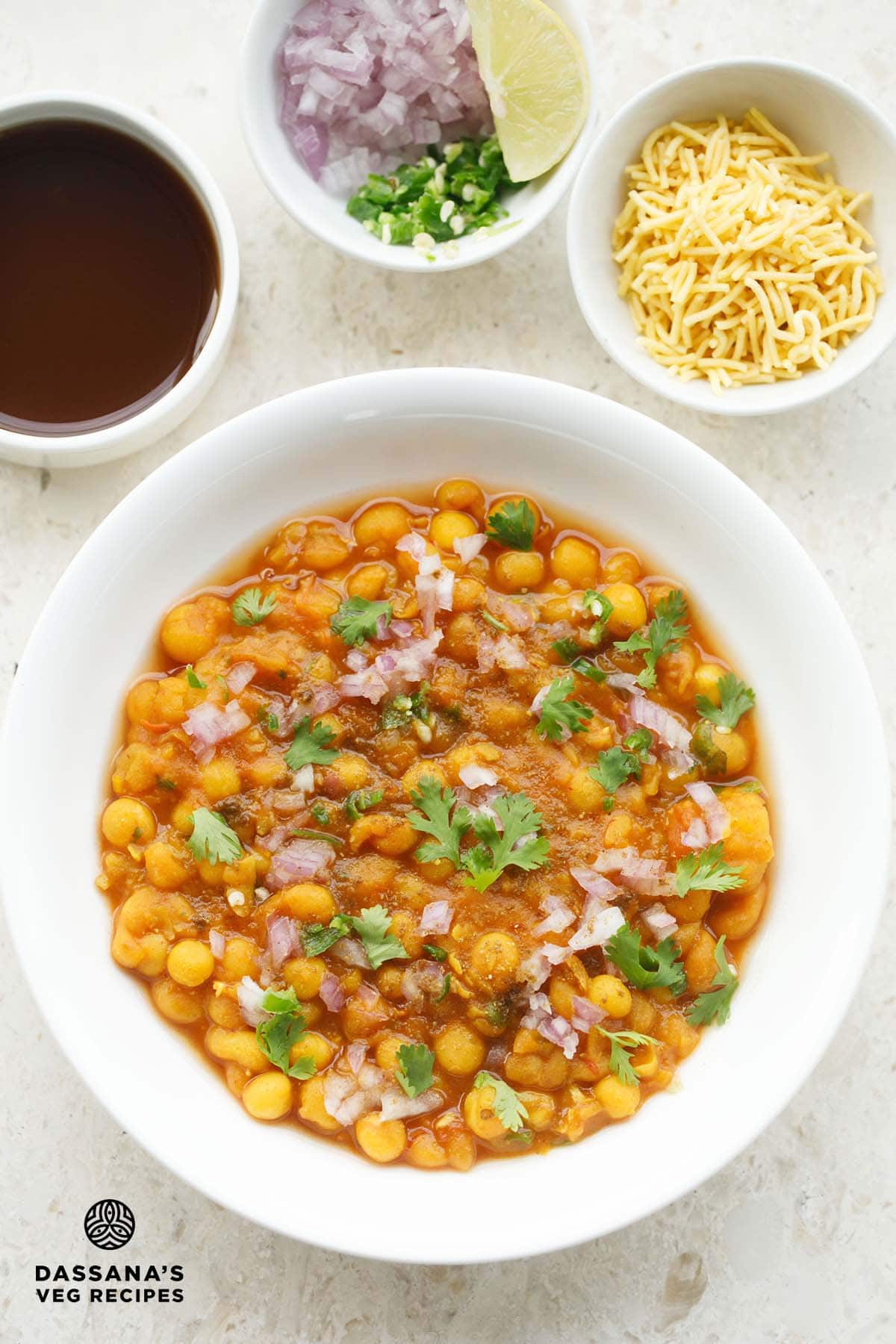

About Ghugni
This is a one-pot Kolkata-style Ghugni Recipe that I learned from a friend’s mom – she makes an absolutely delicious version!
To prepare this Ghugni, you’ll need to soak dried white peas for about 8 to 9 hours, so a little advance planning is required. After that, the rest comes together easily using a stovetop pressure cooker.
The Ghugni Recipe includes bhaja masala, a fragrant roasted spice blend, but you can easily substitute it with garam masala if needed – it still turns out great.
What is Bhaja Masala?
Bhaja Masala is a classic Bengali spice mix, created by dry roasting spices such as cumin, coriander, and fennel seeds, then grinding them into a fragrant powder.
It has a warm, smoky aroma and is typically added as a finishing touch to dishes like Ghugni, chaat and dal for an extra burst of flavor.
This versatile masala enhances the taste of snacks and curries while reflecting the depth and simplicity of Bengali cuisine. Its freshness is best preserved when prepared in small batches at home.
About This Recipe
For this Ghugni Recipe, the spices are tempered in mustard oil, which helps bring out their aroma and flavor. Then, onions, tomatoes, ginger, garlic and spices are sautéed together before adding the soaked peas and water. Everything is pressure cooked until the peas are soft and slightly mushy.
Keep in mind that the cooking time may vary depending on the quality of the peas. The final consistency of this dish should be just right – not too watery, but with a creamy, slightly thick gravy that results from cooking the peas thoroughly.
Once done, you can turn it into Ghugni chaat by topping it with your favorite chutneys and garnishes. Common toppings include chopped onions, green chilies, sev, fresh coriander and lemon juice.
In the authentic Kolkata version, tamarind water is used to add a tangy kick. But if you prefer a sweet and tangy flavor in the Ghugni Recipe, Tamarind Chutney is a great alternative – it adds depth with its blend of sweetness, spice and tang.
Personally, I love using tamarind chutney instead of tamarind water because it complements the soft, savory peas with sweet and tangy notes, while the toppings bring in crunch, heat and freshness.
Ghugni usually has a hint of sweetness too, thanks to a touch of sugar. Feel free to adjust that to your taste – skip it or add a bit more if you like it sweeter.
Ghugni vs Ragda
Although both dishes are made using white peas, they differ in flavor and purpose. Ragda, a Maharashtrian preparation, is typically milder and serves as a base for chaats.
On the other hand, Ghugni, popular in Eastern India, is more robust and spiced, often enjoyed on its own or paired with items like potato tikkis to create dishes such as Ragda Patties.
My Kolkata Food Journey
I’ve visited Kolkata a few times and absolutely loved the street food there. I tried Puchka, Jhal Muri, Aloo Kabli, Ghugni, Shingara, Telebhaja and of course, the sweets (mishti).
The flavors were so unique and vibrant, each bite took me deeper into the city’s rich culinary culture. I even recreated a few sweets at home, like Rasgulla, Sandesh, Chamcham, and Mishti Doi, and shared the recipes on my blog.
Kolkata’s food truly captures the essence of the city, and every time I return, I’m reminded of the vibrant flavors and the warmth that fill each dish.
Step-by-Step Guide
How to make Ghugni
Soak Dried White Peas
1. First, rinse 1 cup dried white peas thoroughly in water several times. Soak the rinsed white peas in 3 cups of water for 9 to 10 hours or overnight.
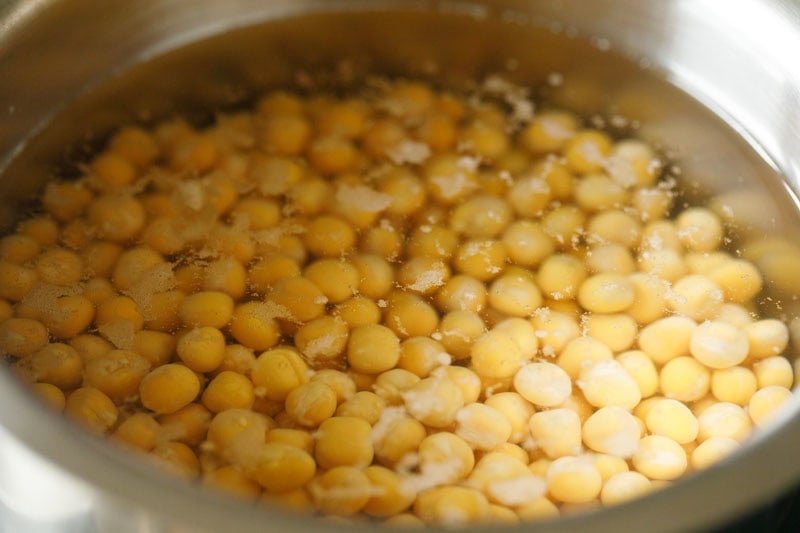

2. By next day, the peas will swell and plump in size. Drain the water.
Rinse the dried peas a few times again with fresh water. Again drain all of the water and set the soaked peas aside.
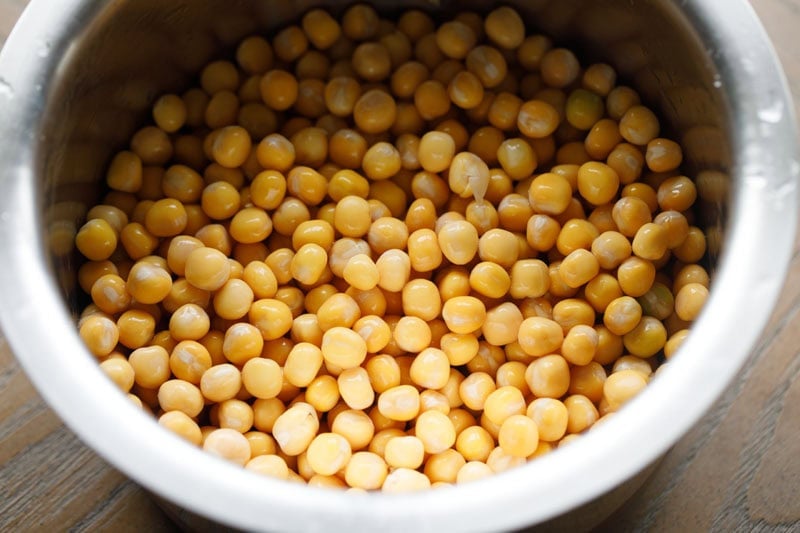

Make Onion-Tomato Masala
3. Place a 3-liter pressure cooker on the stovetop. Keep heat low or medium-low.
Add 2 tablespoons mustard oil and let it become hot. Add the following spices:
- 1 inch cinnamon stick
- 2 cloves
- 1 green cardamom
- 1 dried Kashmiri red chili (seeds removed and halved)
Allow the spices to crackle on low to medium-low heat.
At this point you can also add ½ teaspoon cumin seeds. But since I have added cumin powder later, I chose not to add the cumin seeds.
Adding red chilies are optional. Ensure to use a milder variety, as a hotter one will make the dish very spicy.
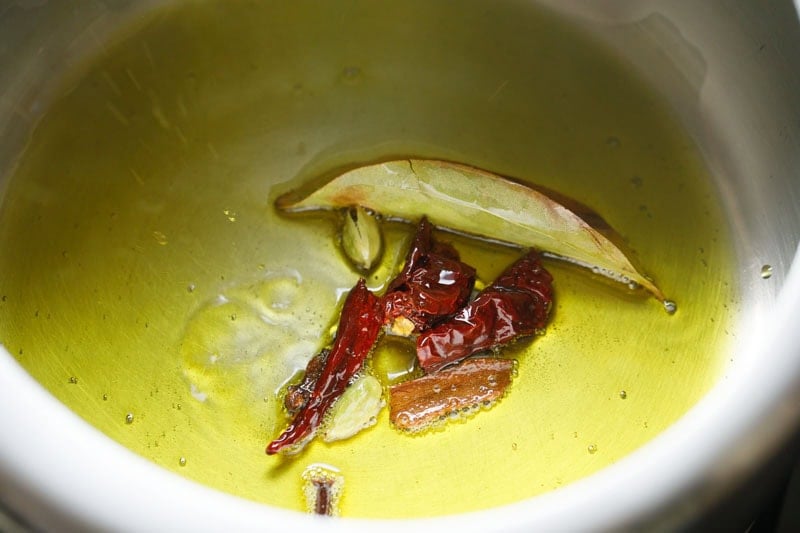

4. Add in ⅓ cup finely chopped onions.
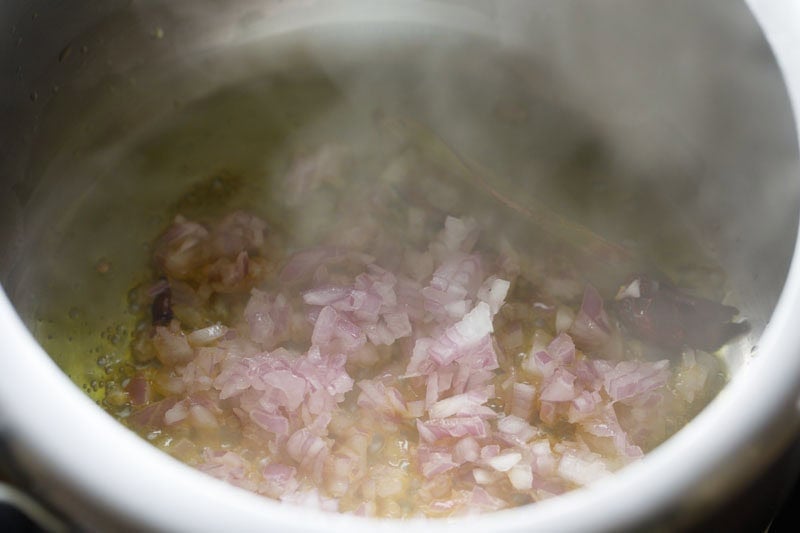

5. Sauté until onions are softened or a light golden.


6. Add 1 teaspoon ginger-garlic paste.
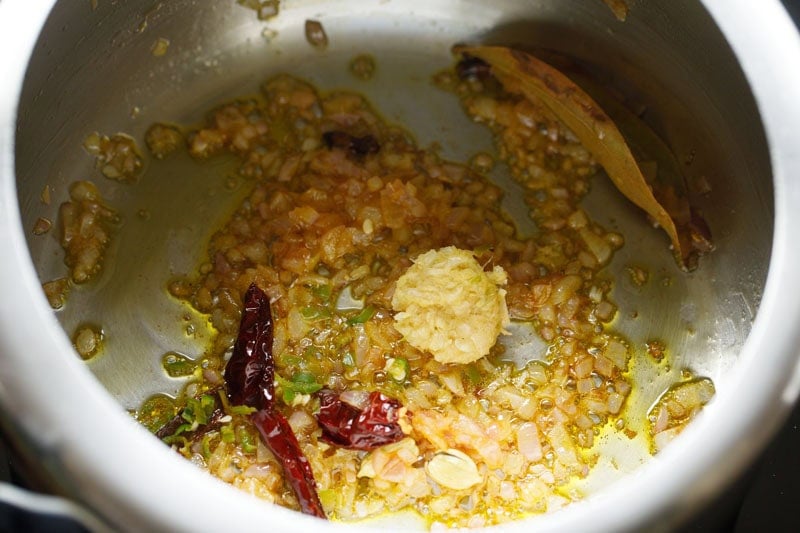

7. Sauté for about 20 to 30 seconds on low heat or until their raw aroma dissipates.
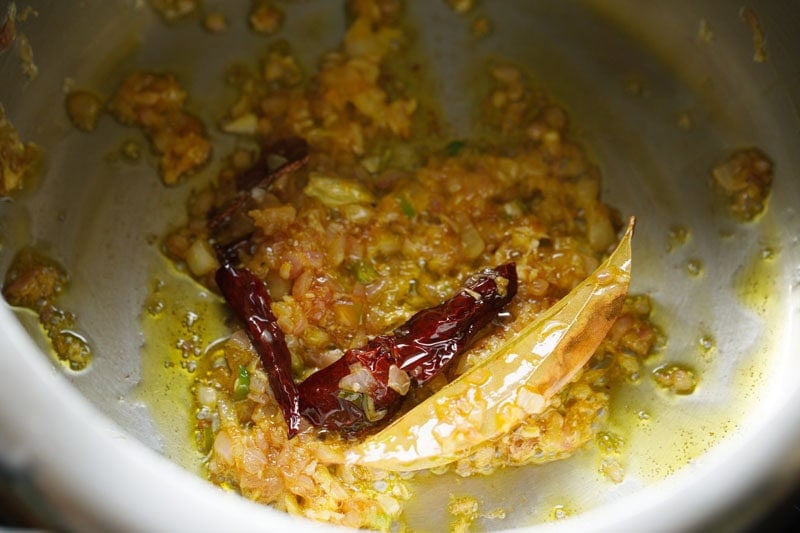

8. Add ½ cup finely chopped tomatoes and sauté on medium-low to medium heat for about 2 minutes.
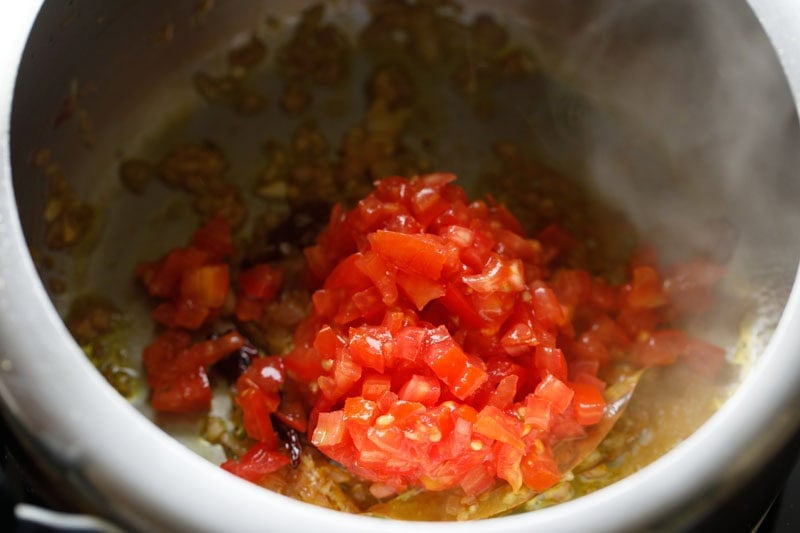

9. Next add the ground spices:
- 1 teaspoon Kashmiri red chili powder
- ½ teaspoon turmeric powder
- 1 teaspoon cumin powder
- 1 teaspoon coriander powder
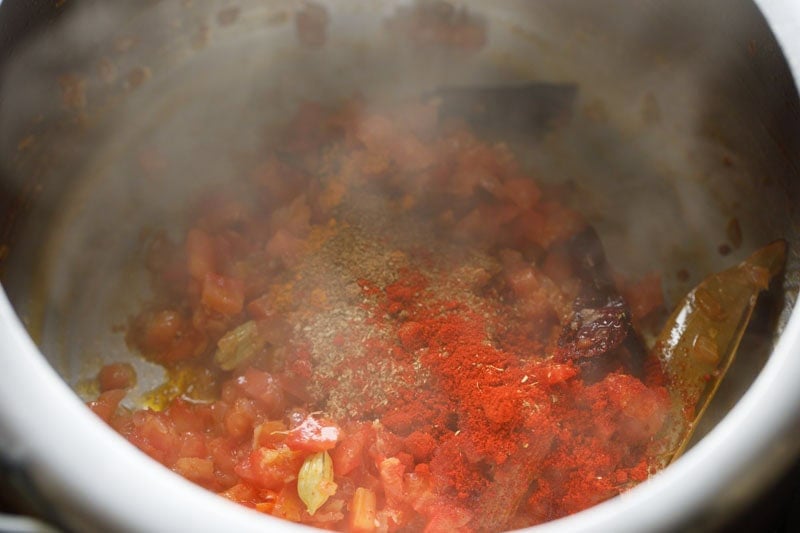

10. Mix thoroughly and sauté until the onion-tomato masala looks glossy with the tomatoes softened completely. You will also see a bit of oil separating at the sides.
If the masala starts sticking onto the cooker, add a splash of water and mix.
It is important that the ground spices cook well.
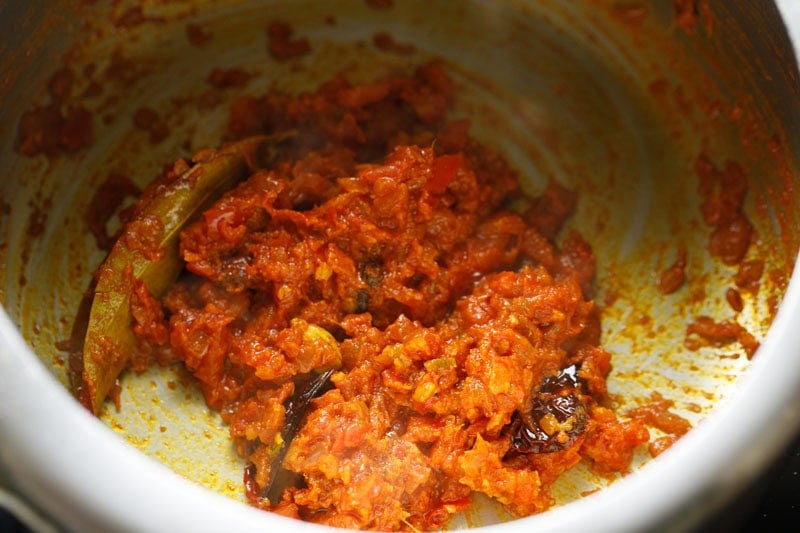

Make Ghugni
11. Add the soaked and rinsed peas, ½ to ⅔ cup chopped potatoes and season with ¼ teaspoon sugar and add salt according to taste.
You could add slightly more sugar if you like.
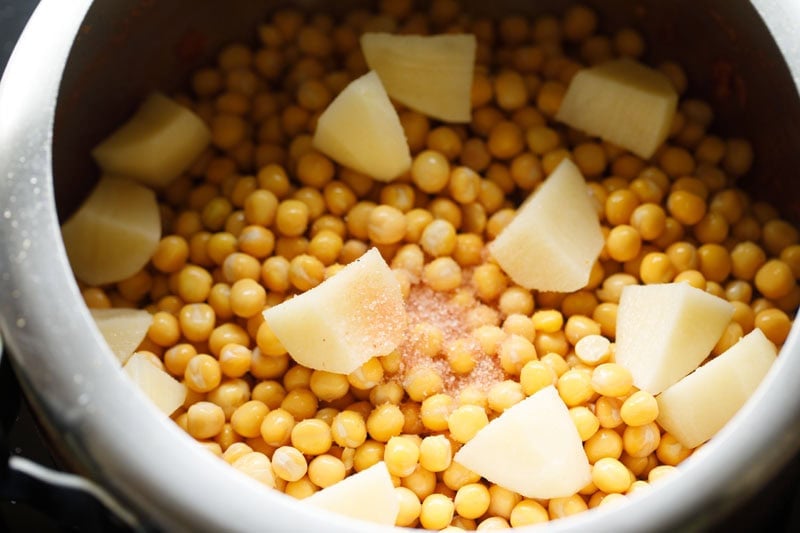

12. Stir and mix to combine.
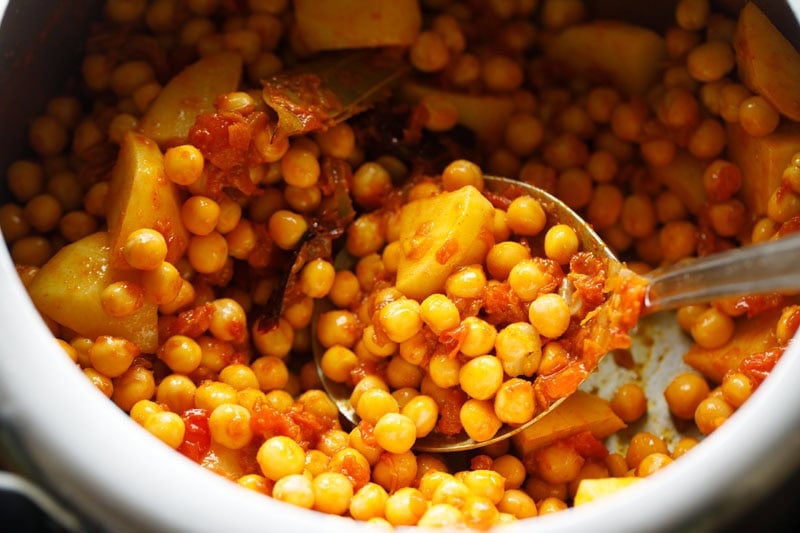

13. Add 2½ cups water and mix again. Let this mixture simmer on medium-low heat for 2 to 3 minutes.


14. Seal the cooker tightly with its lid and pressure cook on medium heat for 15 minutes. Once the pressure drops naturally in the cooker, then open the lid.
Check if the peas have softened well. Also, check the consistency of the Ghugni.
If the peas are al dente or undercooked, pressure cook again for 5 minutes or more. Add water, if needed when pressure cooking the second time.
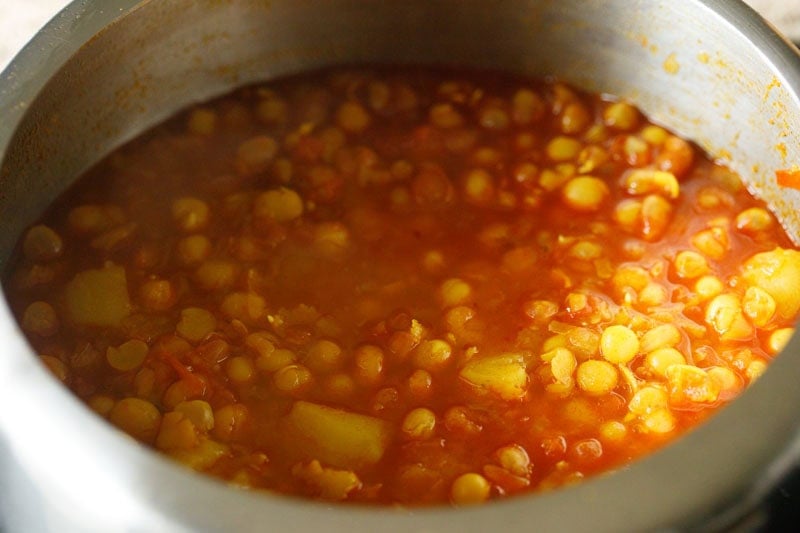

15. If the consistency is runny, keep the cooker on stovetop and simmer until the consistency thickens.
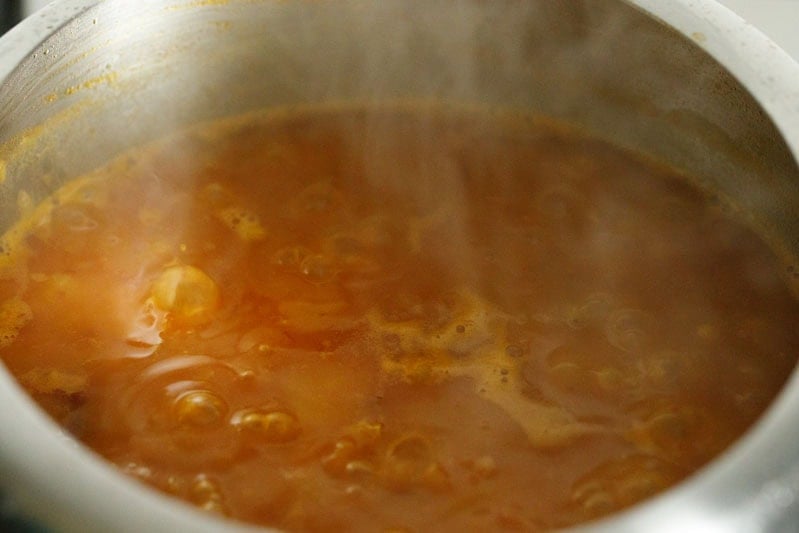

16. The peas must be softened well and there must not be any bite to them. Remove the red chilies when simmering further as they can soften too much and disintegrate into the curry.
The consistency is not runny nor very thick, but kind of in-between.


17. Lastly, add ¼ teaspoon bhaja masala or garam masala.
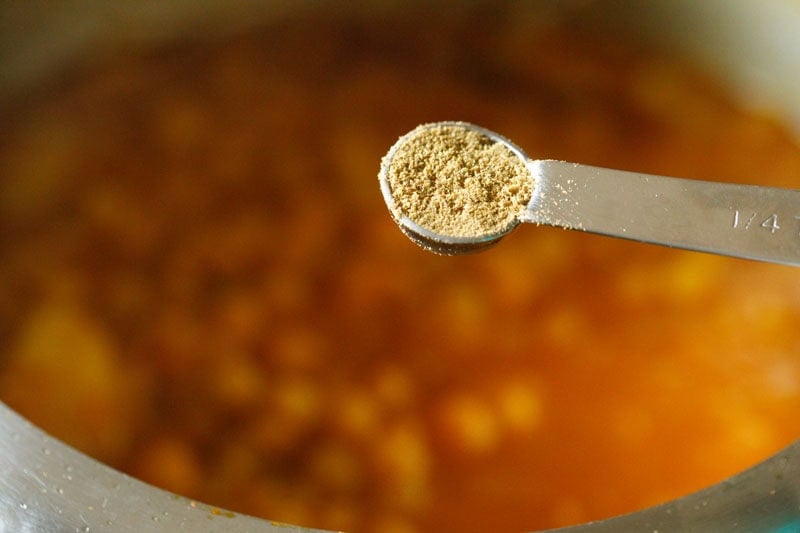

18. Add 1 to 2 tablespoons chopped coriander leaves. Mix well and set aside. Taste test and add more salt, if required.
Keep in mind that the consistency will thicken as the dish cools. So, you will need to add some water when you reheat it.
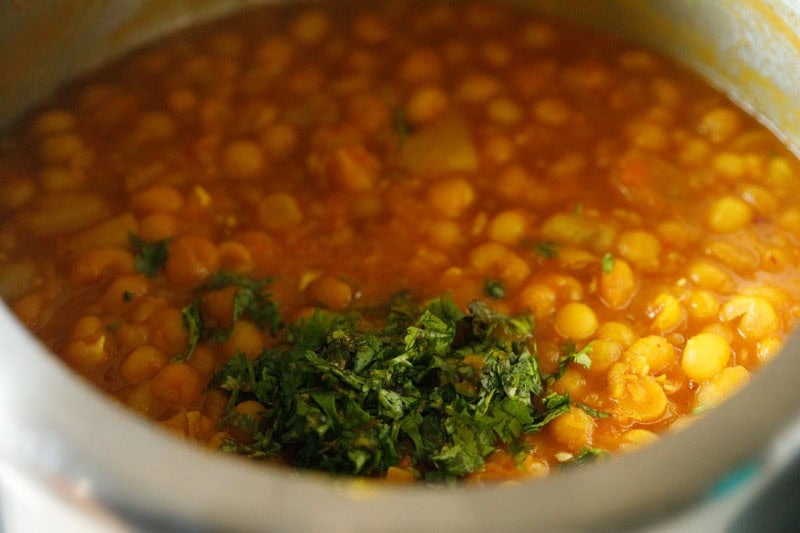

Make Tamarind Water
19. Rinse and soak 2 tablespoons dried tamarind in ½ cup hot water for 20 to 30 minutes.
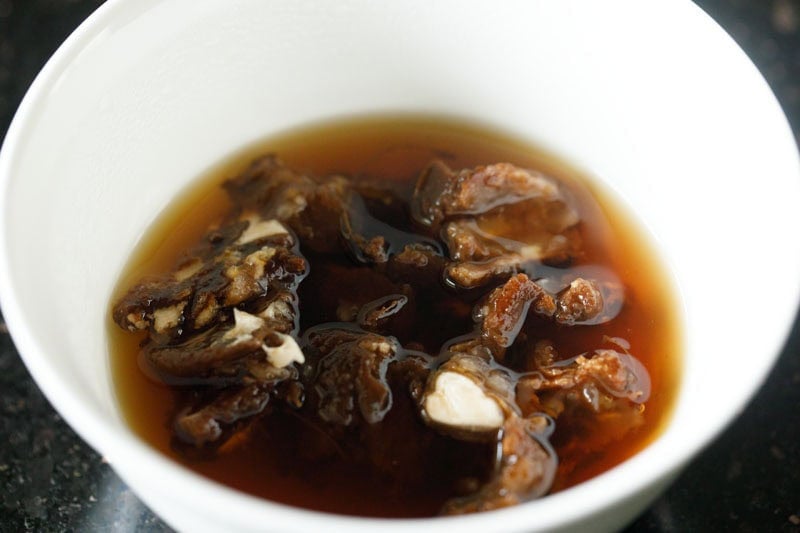

20. Squeeze the softened tamarind and extract its pulp in the water itself. Strain this tamarind water and set aside in a separate bowl.
Also, chop finely onions, green chilies and coriander leaves. You could also consider adding tomatoes, cucumber and raw mango, when in season for the topping. Cut a lemon in quarters.
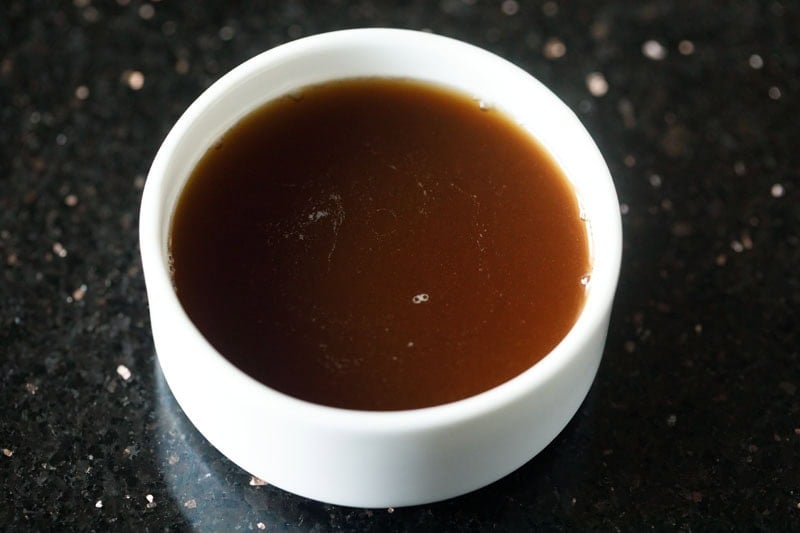

Make Ghugni Chaat
21. Pour the Ghugni in a bowl.
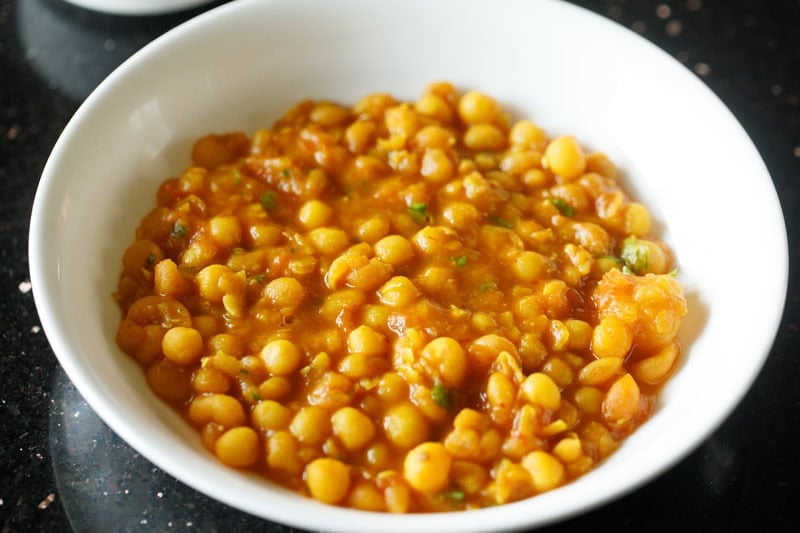

22. Top with some chopped onions, green chilies, tamarind water as needed, coriander leaves and sev.
Do not forget to sprinkle some bhaja masala or chaat masala. Drizzle some lemon juice.


23. Mix and enjoy Ghugni Chaat.
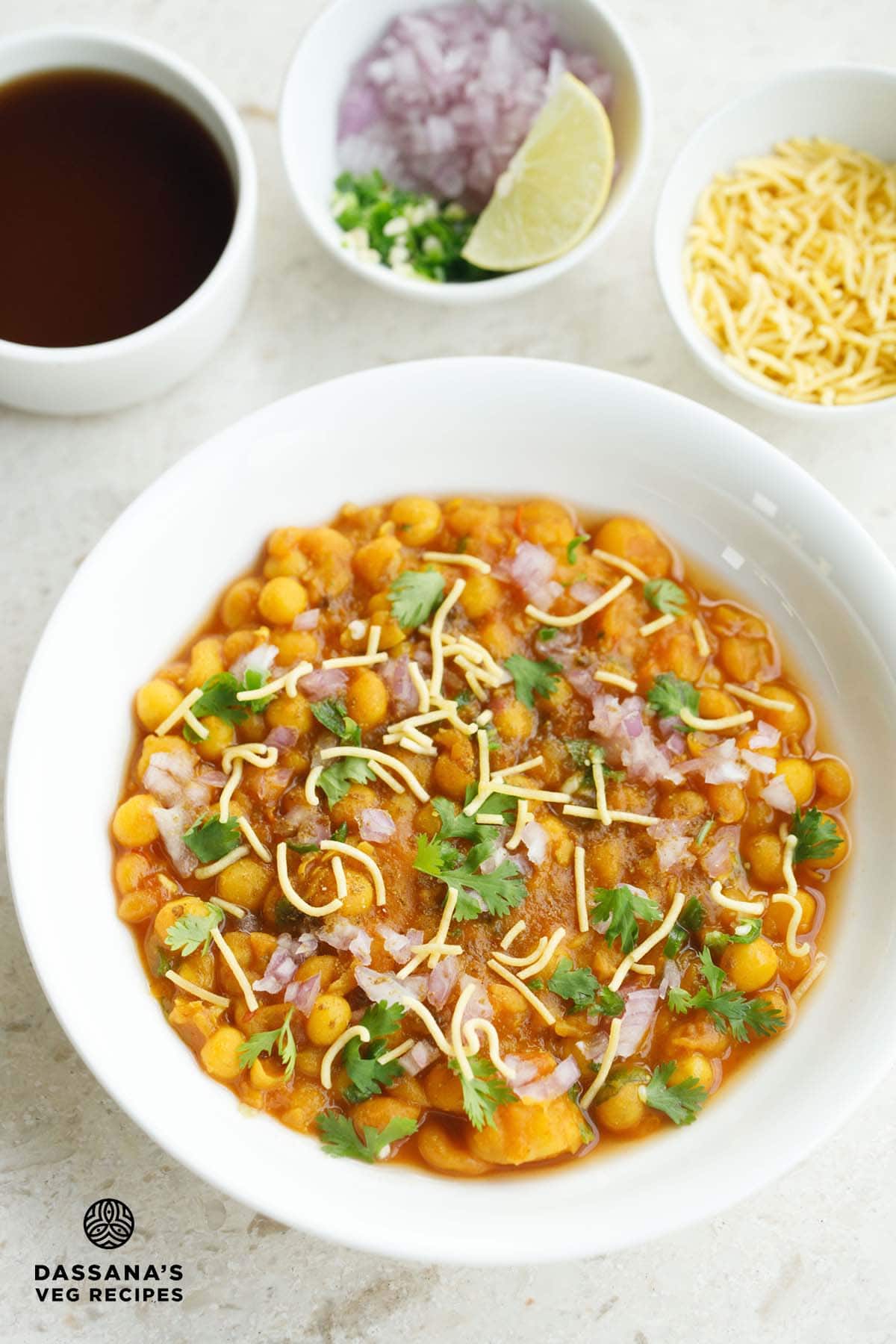

Serving Suggestions
- Ghugni Chaat can be relished on its own or paired with puffed rice (muri), topped with chopped vegetables and tamarind chutney. It also makes a delicious side dish when served with lightly toasted bread, Luchi, Poori or Paratha.
- For a true street-style experience of this Ghugni Recipe, serve it in small bowls or eco-friendly leaf bowls along with a wooden spoon.
- To recreate the traditional Kolkata chaat style, top it with finely chopped onions, green chilies, tomatoes, boiled potatoes, a dash of black salt and a squeeze of lemon juice. Add a sprinkle of sev, crushed papdi or some puffed rice for a delightful mix of textures.
- Prefer a sweet and tangy flavor? Swap the tamarind water for tamarind chutney for a richer taste.
- Potatoes can also be sautéed or fried separately for added texture rather than being cooked with the peas.
- For an Odia-style twist, add some chopped or sliced coconut. Lightly fry the coconut in oil before mixing it into the Ghugni for added richness.
- In Odisha and Assam, fresh grated coconut or raw mango is sometimes used as a garnish to add a refreshing tang and extra texture in the Ghugni Recipe.
- For a final touch, drizzle a bit of ghee or mustard oil over the finished dish for an extra layer of flavor.
Expert Tips
- Peas (white or yellow peas/motor): Soak the dried peas for at least 8 hours or overnight to ensure they soften properly. If you’re using fresh or frozen green peas, remember they cook much quicker, so adjust the cooking time accordingly.
- Cooking peas: The peas should be thoroughly cooked until they’re soft and slightly mushy – not firm or al dente. This entire one pot dish can also be cooked in an Instant Pot.
- Use of mustard oil: Mustard oil adds a bold, pungent flavor that defines traditional Ghugni. Don’t skip it – it’s a key ingredient for the dish’s depth and authenticity.
- Spices: For an authentic flavor, use roasted cumin powder and bhaja masala, the traditional Bengali roasted spice blend. If bhaja masala isn’t available, garam masala is a good substitute. A touch of black salt or chaat masala can also be added for a hint of tang.
- Tamarind or lemon juice: Tamarind water brings the signature tang to the dish. You can swap it with lemon juice, amchur (dried mango powder), dry pomegranate seeds powder or even dried kokum for a similar sour note.
- Beans or lentil variations: For a Bihari-style version, try using black chickpeas (kala chana). You can also use green peas – fresh, frozen or dried – depending on what you have on hand.
FAQs
Ghugni does not have a direct English name, as it is a traditional regional dish from Eastern India. However, it can be described in English as a spiced white pea curry. This flavorful curry made with soaked and cooked dried peas is often served as street food or a side dish with flatbreads or puffed rice (muri).
Yes, Ghugni Recipe is naturally vegan and gluten-free. It is made from dried white or yellow peas cooked with spices, onions, tomatoes and mustard oil – no dairy or gluten-containing ingredients are used in the traditional recipe.
Absolutely! Ghugni is a wholesome and protein-rich dish, especially when made with minimal oil. The peas are a great source of plant-based protein, fiber and essential nutrients. It’s filling, nutritious, and can be a healthy addition to your diet when prepared with less oil and served with fresh toppings.
Bengali Ghugni Recipe is typically made with dried white or yellow peas that are soaked and then pressure-cooked. It’s flavored with mustard oil, bhaja masala (a Bengali roasted spice blend), turmeric, ginger, garlic, onions and tomatoes. It’s often finished with tamarind water or lemon juice and topped with chopped onions, green chilies, and sometimes boiled potatoes or coconut for added flavor and texture.
Yes, it can be made minus onion and garlic. Temple-style Odia Ghugni Recipe and some Assamese versions are made without onion and garlic. You can flavor the curry using just ginger, green chilies, cumin and asafoetida (hing).
More Bengali Recipes To Try!
Please be sure to rate the recipe in the recipe card or leave a comment below if you have made it. For more vegetarian inspirations, Sign Up for my emails or follow me on Instagram, Youtube, Facebook, Pinterest or Twitter.
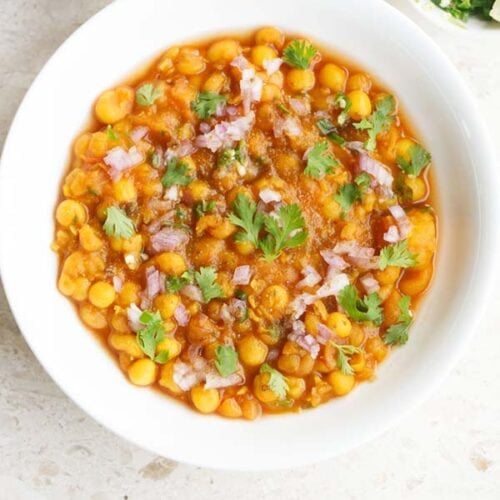

Ghugni Recipe | How to make Ghugni Chaat
Ghugni is a flavorful street food from Eastern India made with dried white peas simmered in a spiced onion-tomato curry. Often cooked in mustard oil with whole spices and bhaja masala, it’s topped with onions, green chilies, coriander, and lemon. Served as a snack or light meal with bread, poori, or as Ghugni Chaat with tamarind water, sev, and puffed rice.
Prep Time 10 minutes
Cook Time 25 minutes
Soaking Time 9 hours
Total Time 9 hours 35 minutes
Prevent your screen from going dark while making the recipe
Soaking White Peas
Firstly rinse the dried white peas in water several times.
Soak the rinsed white peas in water for 9 to 10 hours or overnight.
They will plump up in size the next day. Drain the water. Rinse the dried peas a few times again with fresh water. Drain all the water and set the soaked peas aside.
Making Ghugni
Place a 3 litre pressure cooker on the stovetop.
Keep heat low or medium-low.
- When the oil becomes shot, add cinnamon, cardamom, tej patta, dry red chilli and cloves. At this point you can also add ½ teaspoon cumin seeds if you do not add cumin powder later.
Allow the spices to crackle on low to medium-low heat ensuring they do not burn.
Add in the finely chopped onions. Sauté until onions are softened or a light golden.
Add ginger garlic paste and sauté for about 20 to 30 seconds on a low heat or until their raw aroma dissipates.
Add the finely chopped tomatoes and sauté for about 2 minutes on medium-low to medium heat.
Next add the ground spices – Kashmiri red chilli powder, turmeric powder, cumin powder, coriander powder.
Mix thoroughly and sauté until the onion-tomato masala looks glossy with the tomatoes softened completely. You will also see a bit of oil separating at the sides.
If the masala starts sticking onto the cooker, add a splash of water and mix. It is important that the ground spices cook well.
Add the soaked and rinsed peas, chopped potatoes and season with sugar and add salt according to taste.
Stir and mix to combine.
Add water and mix again.
Let this mixture simmer for 2 to 3 minutes on medium-low heat.
Seal the cooker tightly with its lid and pressure cook for 15 minutes on medium heat.
Once the pressure drops naturally in the cooker, then only open the lid.
Check if the peas have softened well. Also check the consistency of the ghugni.
If the peas are al dente or undercooked, pressure cook again for 5 minutes or more. Add water if needed when pressure cooking the second time.
If the consistency is runny, keep the cooker on stovetop and simmer ghugni until the consistency thickens.
- The peas must be softened well and there must not be any bite to them.Remove the red chillies when simmering further as they can soften too much and disintegrate into the curry.
The consistency of ghugni is medium—not too runny or thick. It has enough gravy to coat the peas, giving it a smooth, slightly saucy texture that’s perfect for serving with poori, paratha, or as a chaat with puffed rice and other toppings.
Lastly add bhaja masala or garam masala powder.
Add chopped coriander leaves. Mix well and set aside. Check the taste and add more salt if needed.
Keep in mind that the consistency will thicken as ghughni cools. So you will need to add some water when you reheat it.
Making Tamarind Water
Rinse and then soak the dried tamarind in ½ cup hot water for 20 to 30 minutes.
Squeeze the softened tamarind and extract its pulp in the water itself.
Strain this tamarind water and set aside.
More Preparation
Also chop finely onions, green chillies and coriander leaves. You could also consider adding tomatoes, cucumber and unripe green mango, when in season for the topping. Chop the lemon in quarters.
Assembling & Serving Ghugni Chaat
- Pour ghughni in serving bowls. Top with some chopped onions, green chillies, tamarind water, coriander leaves, and sev. Do not forget to sprinkle some bhaja masala or chaat masala on the ghughni.
Drizzle some lemon juice. Mix and enjoy the Ghugni Chaat
You can enjoy Ghugni on its own or serve with lightly toasted bread, luchi or poori.
- If you like some sweet taste, instead of tamarind water, use sweet and tangy Tamarind Chutney.
You can also add some sliced or chopped coconut. Fry the chopped coconut in some oil and add to the ghughni.
Optionally, drizzle a bit of mustard oil or ghee on the ghugni while serving.
- Peas: Use good quality dried peas that are not old or aged. Remember to soak the dried peas in water for at least 9 hours. Optionally you could use dried green peas, kala chana (black chickpeas) instead of white peas. Another variation is to make the dish with fresh or frozen green peas.
- Cooking: These peas after soaking get cooked really well in a pressure cooker. Do not try to cook them in a pan or stovetop as they may take hours to cook and may not cook well. Make sure that the peas have softened really well and have a mushy texture. Do not cook the peas until al dente texture.
- Potatoes: The potato cubes can be sautéed or fried separately, instead of cooking together with the dried peas.
- Cumin: Opt to skip the cumin powder and add cumin seeds, while tempering the whole spices. Since I have added cumin powder, I chose not to add the cumin seeds.
- Red Chillies: Adding red chillies are optional. Ensure to use a milder variety, as a hotter one will make your ghughni very spicy.
- Spicing: Adjust the spices as needed. For a spicy ghugni chaat add more green chillies as a topping.
- Spices: Use bhaja masala (a Bengali roasted spice mix) for authenticity. If you do not have bhaja masala, add garam masala. Add a pinch of black salt or chaat masala for tanginess.
- Tamarind or Lemon Juice: Tamarind water adds the signature tangy note. You can substitute with lemon juice or amchur (dry mango powder)
- Mustard Oil: Traditional Ghugni is best made in mustard oil for its pungency and depth. So do not skip on it. It is an essential ingredient.
Nutrition Facts
Ghugni Recipe | How to make Ghugni Chaat
Amount Per Serving
Calories 307 Calories from Fat 72
% Daily Value*
Fat 8g12%
Saturated Fat 1g6%
Polyunsaturated Fat 2g
Monounsaturated Fat 4g
Sodium 349mg15%
Potassium 817mg23%
Carbohydrates 48g16%
Fiber 16g67%
Sugar 10g11%
Protein 14g28%
Vitamin A 501IU10%
Vitamin B1 (Thiamine) 0.4mg27%
Vitamin B2 (Riboflavin) 0.2mg12%
Vitamin B3 (Niacin) 2mg10%
Vitamin B6 0.3mg15%
Vitamin C 27mg33%
Vitamin E 0.5mg3%
Vitamin K 14µg13%
Calcium 78mg8%
Vitamin B9 (Folate) 153µg38%
Iron 4mg22%
Magnesium 87mg22%
Phosphorus 231mg23%
Zinc 2mg13%
* Percent Daily Values are based on a 2000 calorie diet.

Source link